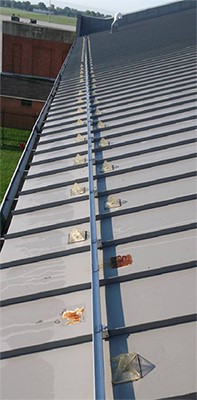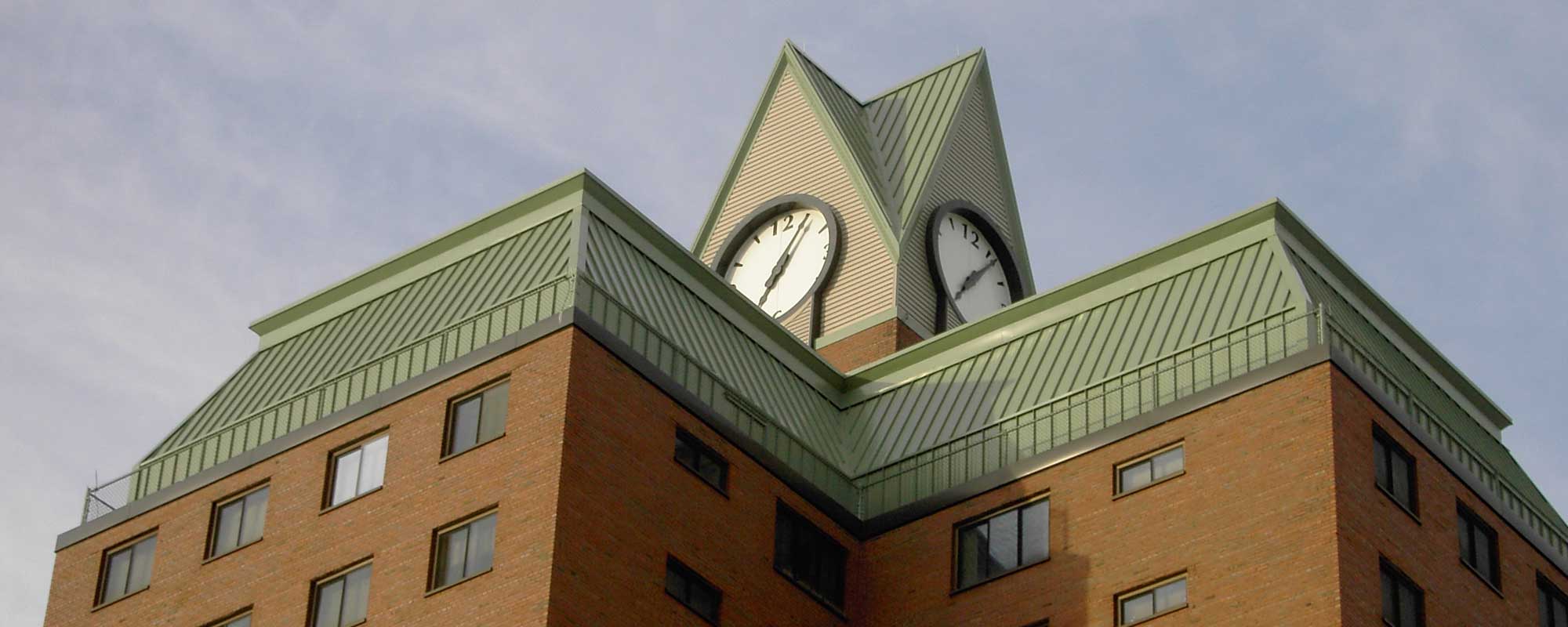Snow Guards
If your building is in snow country, you should consider whether you need to install a snow guard system on your metal roof. Painted metal systems have a much slicker surface than some systems such as shingles. The kynar paint systems that dominate the metal roof market are a country cousin to Teflon. As such, they are more prone to large, sudden slides of snow or ice falling off the roof. These can cause substantial damage to people or property below. Do you have entrances or walkways where snow slides could injure people walking down below? Do you have landscaping or other items below the roof that could be damaged? If so, you should consider installing a snowguard system in those areas. ( If you don’t have those conditions, letting the snow slide off the roof may be your best bet. )
There are dozens of snow guard systems on the market today. The two major category types are individual snow block pieces and continuous rails. Individual unit systems are usually plastic or metal pieces that are either glued or mechanically fastened in the flat pan of each roof panel. The shapes of these blocks are designed to disrupt the smooth surface of the panels and catch the snow so it can’t slide.
Rail systems are usually continuous metal extrusions or rods that run across the tops of the panel ribs. They are fastened to the top of the panel ribs with non- penetrating metal blocks that clamp to the rib. They generally have snow flaps that attach to the rail and extend down to the flat pan of the panel. The rail will catch and block large snow or ice slides, while the flaps will stop smaller slides that could pass under the rail.

Ultra seam does not promote the use of the individual snow blocks on our roof systems do to several factors. These are:
1. Mechanically attached snow blocks put holes in panels, greatly increasing the potential for future leaks, and they also inhibit panel movement that occurs with expansion and contraction.
2. Glue on units have adhesive application temperature limitations that restrict their use from mid fall to mid spring.
3. Adhesive applications have a limited snow load resistance. Over time you may encounter issues with the snow blocks falling off. You may consider them for smaller roofs and lower slopes where the impact load will be less.
4. In order for the units to adhere to the kynar paint surface, the adhesive has to chemically attack the paint. This can destroy the integrity of the paint.
As you can see in the picture to the left, this building originally had snow blocks installed. Over time some of these fell off. Beyond the fact that this would allow snow to slide on those panels, you can see where the adhesive on the missing snowguards caused a complete failure of the paint. Heavy rusting is apparent at those spots.
Subsequent to this problem occurring, the owner opted to install a continuous rail type system. Painting of the panel rust areas is required to prevent rust through failure of the metal roof system.
Clamp on snow rails systems have shown the capability of holding up to higher impact loads. In the picture below you can see a snow guard that was installed on a roof with very long panels in heavy snow country. The impact load of the snow / ice slide was so great that the snow clamp- which did not come off- literally tore the rib off of the panel.

This illustrates another important aspect of designing a snow guard system. On large roof areas with long panels and / or steep slopes, you may require more than one row of snow guards to adequately control the forces exerted by a sudden “avalanche” of snow and ice cascading down the roof. On the building that the roof clamp shown above came from, the owner had cut down on the recommended rows of snow rails to save money. This resulted in a total failure of a number of panels on the roof.
If you are in need of a snow guard system for your roof, you should consult with your local Ultra Seam installer or plant. They will help you get a snow retention system that is designed to stay on the roof, not damage the panel system, handle snow loads that will be encountered, and prevent damage or injury to the ground below the roof.

